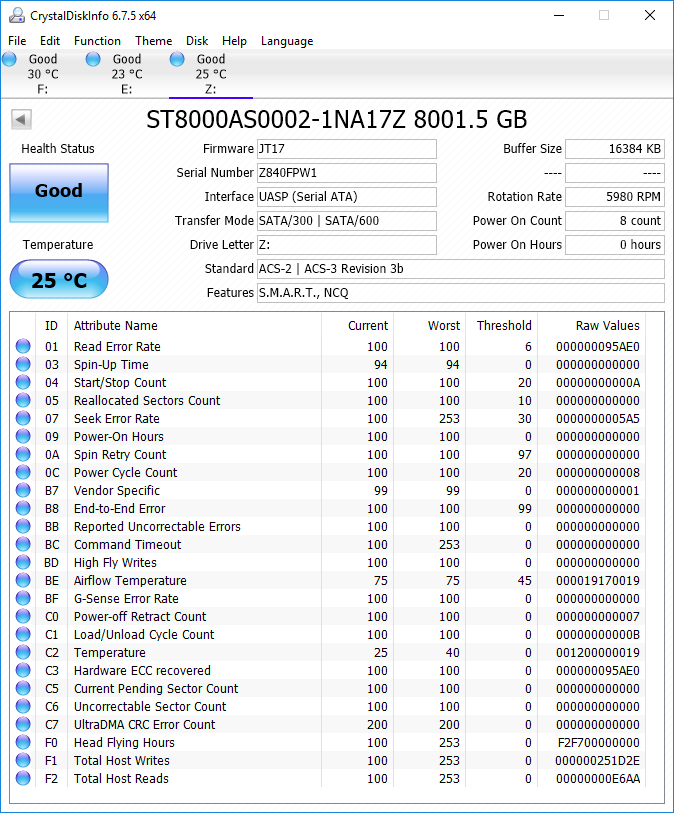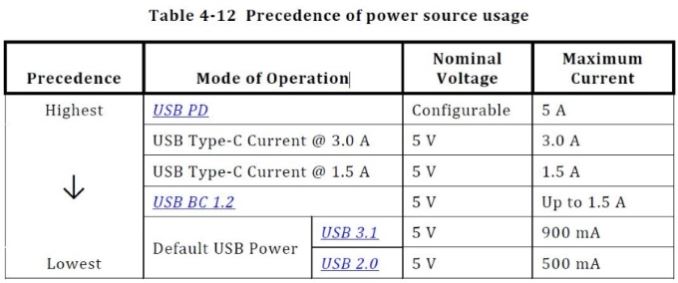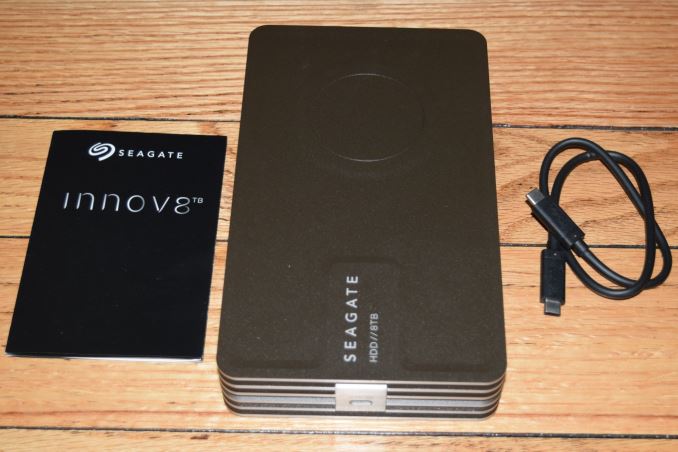Seagate Innov8 8TB Bus-Powered External Hard Drive Review
by Ganesh T S on May 19, 2016 8:30 AM EST
Bus-powered storage devices have traditionally been limited by USB 2.0's power delivery specifications.
The 4.5W limit meant that only 2.5" drives (typically with a spindle speed of 5400 RPM) could be placed
behind a USB - SATA bridge. Last month, Seagate introduced the world's first bus-powered desktop hard drive enclosure. The Innov8 8TB external hard drive uses a Seagate Archive HDD and comes with a USB 3.1 Gen 1 Type-C interface. This review looks at the hardware design of the Innov8, followed by a look at some benchmark numbers and performance consistency test results.
Background
Storage devices that are powered over USB have to make sure not to exceed the maximum guaranteed power available through the port. In the case of early USB 2.0 host ports, only the default power profile (2.5W - 5V @ 500mA) was supported. This meant that even 5400 RPM 2.5" drives behind a SATA - USB bridge had to use a second USB cable just for drawing additional power.
USB 3.0 bumped up the default power to 4.5W (5V @ 900mA). Thankfully, even the USB 2.0 ports on various computers started adopting this profile - ensuring that the traditional 2.5" drives in a SATA-to-USB enclosure could operate with just a single cable. USB 3.1 Gen 2 still maintains the default power delivery at 4.5W (5V @ 900mA), but it has a number of additional power delivery profiles that we will touch upon further down in this review.
Desktop hard drives (3.5") have usually had 7200 RPM spindle speeds. This usually placed the power consumption of the drives under load around 10W, with start-up spikes being much higher. However, the advent of hard drives meant for usage in consumer NAS units and the replacement of tapes with hard drives for archive storage has made 5400 RPM-class 3.5" drives an attractive proposition for hard-drive manufacturers.
Seagate introduced the Archive HDD last year specifically for archive storage. The capacity bump was realized using Shingled Magnetic Recording (SMR) instead of traditional pure Perpendicular Magnetic Recording (PMR) platters. This enables storage densities of up to 1.33TB/platter. Seagate has been using the Archive HDD in the Seagate Backup Plus 8TB External Hard Drive for some time now. The Seagate Innov8 also uses the same drive, albeit with different hardware.
The 8TB Seagate Archive HDD has power numbers ranging from 5W at idle to 7.5W for random reads. This makes it unsuitable for pure bus-powered designs, which is the reason for the Seagate Backup Plus External Hard Drive to come with a separate power adapter. The Innov8 moves to a Type-C interface, and it only bundles a Type-C to Type-C cable - indicating that it is not supposed to be used with a Type-A port.
The Innov8 works with Type-C hosts which advertise Power Delivery of 1.5A or higher. If the host does not advertise 1.5A or greater, the Innov8 will not spin up and will flash an error LED signal.
Given that hard drives have spin-up power requirements that might be much higher than the quoted power numbers (7.5W for random reads in the Archive HDD) in the specifications, and USB ports typically have a hard limit on the power delivery aspect, Seagate's design of the Innov8 is indeed worthy of detailed investigation.
Hardware Design
The Seagate Innov8 packaging is indicative of a premium product - a flip top box with a magnetic catch. Inside the package, we have the main unit - a 208mm x 123.6mm x 36mm aluminum enclosure weighing 1.5 kgs. It has six layers around the edges, as shown in the picture below. The feel in hand is quite solid, and the industrial design is praiseworthy.
The chassis has no visible screws on the outside, and four small rectangular rubber feet on one end is indicative of the side meant to be the base when placing the unit on a desk. The gallery below shows the various aspects of the chassis design and the placement of the USB 3.1 Type-C port.
Accessing the internals of the unit involves prying open the two sides of the chassis along the two middle layers on the side.
Internal Components
Opening up the chassis reveals a full metal shield with two exposed screws at the USB Type-C port end. These anchor the SATA - USB bridge board to the chassis frame. The screws fastening the Archive HDD to the metal shield are hidden by rubber bushings. The gallery below presents some teardown pictures.
Important internal components to note include the 8TB Archive HDD with a SATA interface (ST8000AS0002) having firmware version RT17 and the 12.0 Wh LiPo (lithium polymer) battery supplying 3.8 V with a 3162 mAh rating. Not pictured in the teardown gallery is the ASMedia ASM1153 USB 3.1 Gen 1 - SATA bridge chip.
The LiPo battery helps handle the spin-up power requirements and whenever the drive needs to consume power higher than whatever is delivered by the USB port. Seagate has helpfully created a marketing name for this battery usage technology - 'Ignition Boost'. Note that the drive is only compatible with Type-C ports advertising at least 1.5A (7.5W). So, the battery is not needed most of the time. In addition, since the Archive HDD doesn't need 7.5W throughout, the battery can get charged using the USB bus power at other times.

























41 Comments
View All Comments
hlmcompany - Thursday, May 19, 2016 - link
If the lipo does fail at some point, then you RMA the product. If it is out of warranty, then like with any other HDD product, you really have no option. Although, a failed lipo for this device does not necessarily mean you cannot access your data.Gunbuster - Thursday, May 19, 2016 - link
Why not have this use a standard cell like 8650 or CR123A? It would not have been that hard to give it a user accessible battery compartment.DanNeely - Thursday, May 19, 2016 - link
Probably the same reason most phones don't come with replaceable batteries anymore. By the time the battery is dead the remaining hardware would be obsolete. That said, I'd be surprised if someone (probably the night shift of the factory where the OEM batteries are made) doesn't start selling gray market replacements on ebay/etc within a few months.adityarjun - Friday, May 20, 2016 - link
This is an 8TB archive hdd. I would expect it to last for 8-10 years atleast. I have had my current 2TB hdd for 5 years now.This just won't hold up well over time. Once the 2 year warranty expires, anyone who bought this product is going to regret it imho. It really needed to be more modular.
shelbystripes - Thursday, May 19, 2016 - link
This is one of the things that frustrates me about USB in general.To me, this drive is ideal for offsite backup. It has much higher capacity than any other bus-powered drive, and bus-powered drives are ideal because you don't have to worry about keeping track of proprietary AC adapters.
But the wide range of USB power delivery options means we'll keep having devices like this, where it's not clear if I can even use it. The fact that the reviewer got it to work on USB 2.0 ports on one motherboard is great. Some USB ports can deliver well above the minimum spec. But there are USB 3.0 ports that only support the 900mA base spec, and I'm guessing they won't power this thing. And the real problem is, there's no way to tell!
You can't just look at the specs either. My ideal use case is to make offsite backups of my Synology NAS. One 8TB drive would be enough to backup all my critical data, and I could stop using multiple 2.5" drives. But I just spent the last 15 minutes looking through Synology's documentation and they don't publish the power output of their USB ports anywhere. Not online, not in the user manuals, nothing. That doesn't mean the ports can only output 900mA, though, it just means they won't tell me (they tend not to publish the finer details on their SOHO/SMB devices).
The USB power delivery spec is a mess. Even if my devices had a Type-C port, that still wouldn't tell me anything. The minimum requirement for Type-C is still 900mA, the 1.5A mode is optional. You can implement USB 3.0 ("USB 3.1 Gen 1") over Type-C, still only deliver 900mA, and claim USB spec compliance.
Type-C should have come with a 1.5A power delivery requirement. And even then there will be variation on how much more power a device can deliver. USB is getting a lot less universal.
cygnus1 - Thursday, May 19, 2016 - link
I very much agree. I remember with the hype of Type C and USB PD the goal was something like 100W delivered from a Type C host port... I'm guessing the high wattage PD isn't coming anytime soon if these are the kinds of products coming out...hlmcompany - Thursday, May 19, 2016 - link
The spec is there, the technology is there, the implementation lacks because manufactures want to be backward compatible. I wish they would begin to move on and drop the backward compatibility. For a time they could offer two types of products. Although, with the USB connector integrated with the drive's PCBA, they would need to manufacture two different HDD's.CrimsonFury - Friday, May 20, 2016 - link
The 100w power delivery is for power bricks (to standardize USB C for laptop power bricks). It was never intended to provide 100w from a usb port on the PChlmcompany - Friday, May 20, 2016 - link
The intention of PDP over USB Type-C is left up to the design/manufacturing teams using it. The USB-IF spec'ed out for a PDP of 100 watts can be implemented in many ways, including from a PC. The USB-IF even outline the use scenario of USB outlets in public places and on transport. Yet, they also illustrate the PD Rule charging a laptop from a USB hub in a monitor.Notmyusualid - Thursday, May 19, 2016 - link
There is not nearly enough PoE enabled devices in this world for my liking.I was hoping that with all these ultra books around, that the 25W available in just about every commercial office around the globe, could negate the need for business users to carry their adapters to work etc. You know, trickle charging / supporting battery power.
But I'm hopeful the penny will drop one day.